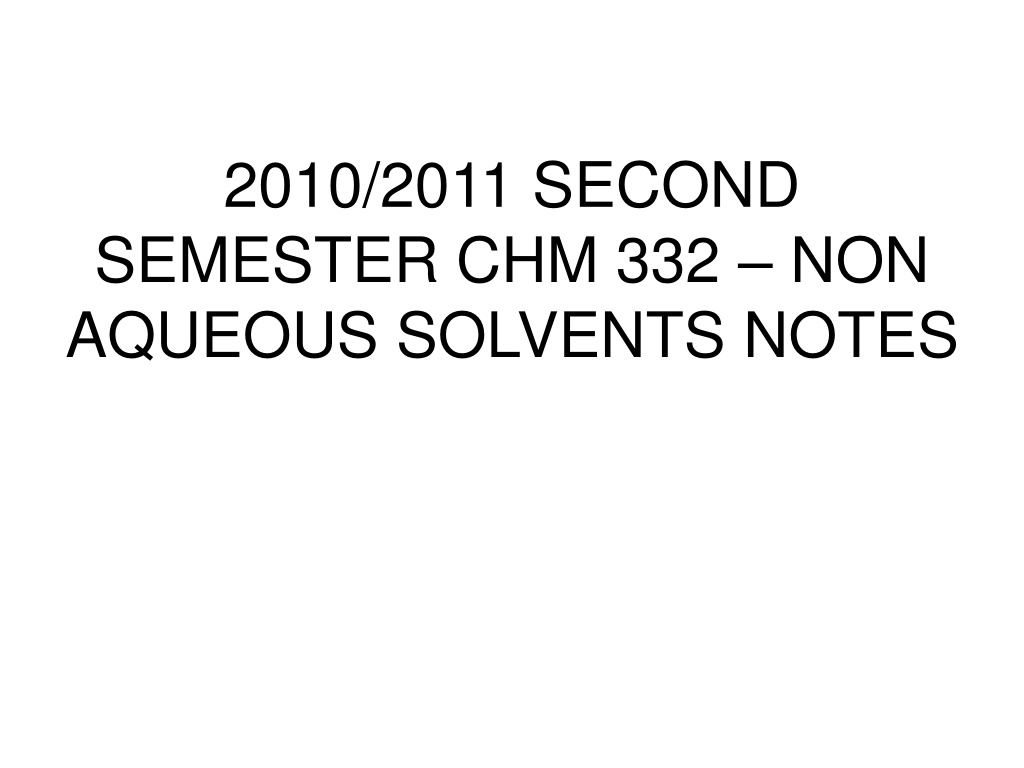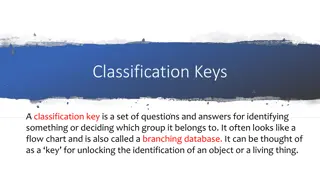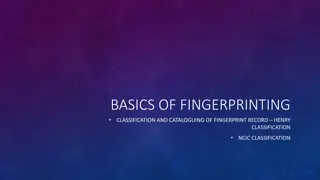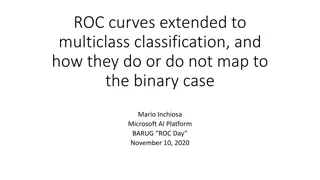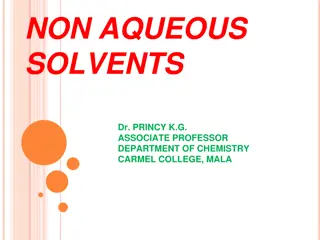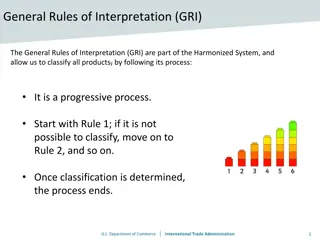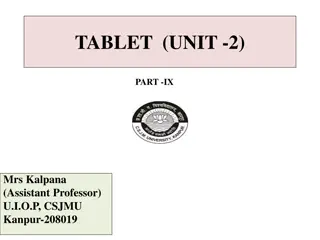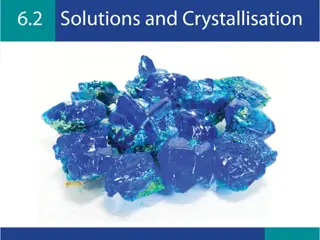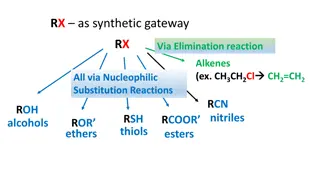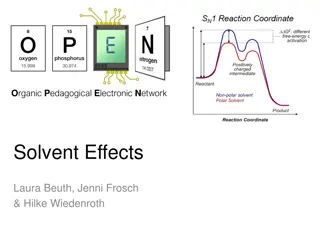Classification and General Characteristics of Solvents
Three types of liquid substances serve as solvents: molecular liquids (e.g., organic and inorganic solvents like HF, liquid ammonia, SO2), ionic liquids (molten salts used at high temperatures), and atomic liquids (e.g., metallic mercury). Generally called non-aqueous solvents, they can be mixed for desired properties. Solvent properties are determined by physical properties like boiling point, melting point, vapor pressure, heat of vaporization, and cohesive energy density.
Download Presentation

Please find below an Image/Link to download the presentation.
The content on the website is provided AS IS for your information and personal use only. It may not be sold, licensed, or shared on other websites without obtaining consent from the author.If you encounter any issues during the download, it is possible that the publisher has removed the file from their server.
You are allowed to download the files provided on this website for personal or commercial use, subject to the condition that they are used lawfully. All files are the property of their respective owners.
The content on the website is provided AS IS for your information and personal use only. It may not be sold, licensed, or shared on other websites without obtaining consent from the author.
E N D
Presentation Transcript
2010/2011 SECOND SEMESTER CHM 332 NON AQUEOUS SOLVENTS NOTES
CLASSIFICATION AND GENERAL CHARACTERISTICS OF SOLVENTS
There are three types of liquid substances that can serve as solvents. They include
molecular liquids: aside from water, they include many organic and some inorganic solvents such as HF, liquid ammonia, SO2
ionic liquids: these are molten salts. They are used at high temperatures
atomic liquids: very few exist at room temperature, metallic mercury is a typical example
generally called non aqueous solvents. Non aqueous solvents are often mixed with water or other non aqueous solvents in order to obtain desirable solvent properties.
Boiling point and Melting point determine the liquid range of solvents. Vapour pressure is a vaporization property and it is useful in determination of the toxicity and hazards of solvents. The heat of vaporization determines the cohesive energy density.
solvent and is related to the work necessary to create cavities to accommodate solute particles in the solvent. It is defined by the equation
Where vH is the heat of vaporization and V mis the molar volume.
The solubility parameter = C1/2= [( vH RT) / V m]1/2 (2)
solutes in low polarity solvents. Two liquid substances with similar values are miscible while those with dissimilar values are immiscible.
vH (Tb ) determines the Trouton s constant [ vS(Tb)/ R] = vH(Tb)/ R. (3)
Solvents with vS(Tb)/ R 12 are structured and those with vS(Tb)/ R 11.6 are non structured.
The viscosity is the resistance of a liquid to flow. It influences the rate of mass transfer and the conductivity of electrolyte solutions. The relative permittivity rinfluences the electrostatic interactions between the electric charges q1and q2placed in a vacuum and separated by a distance r. the electrostatic force F vacbetween them is expressed as F vac= q1q2/ 4 0 r2 (4)
solvent of relative permittivity at a distance r, the electrostatic force F solvbetween the charges is expressed as (5) F solv= q1q2/ 4 0 rr2= F vac/ r
If q1 and q2are of the same sign F vacis a repulsive force. If they are oppositely charged
Absolute permittivity of a material is given as 0 r.
as on the dissolution and dissociation of electrolytes. It is used in classifying solvent polarity or solvating capability. Solvents of low permittivity are classified as apolar or non polar solvents while those of high permittivity are classified as polar solvents. The refractive index nDis defined as the ratio of light speed at the sodium D- line
It is used in obtaining the polarizability, a, of the solvent molecules. Polarizability and refractive index are related by the equation a = (3Vm/ 4 NA) (n2 D 1)/ (n2 D+ 2) (6)
Where NAis the Avogadro constant, Vmis the molar volume. Solvents with
High values of a tend to interact easily with one another or with other polarizable solute particles by dispersion forces. The dipole moment is used to assess solvent polarity. Solvents with high dipole moments are called dipolar solvents. Those with low dipole moments are called apolar or non polar solvents. The dipole moments tend to underestimate the polarity of small solvent molecules because it depends on the distance between the positive and negative charge centers I the molecule.
the induced polarization that occurs for solvent molecules placed in between two plates of capacitor as a vapour is given as equation (7)
r- 1 4NA a + / 3kBT r+ 2 3Vm
kB is the Boltzmanns constant. and a can be obtained from a plot of
Acidity of a solvent is the ability to accept an electron, an electron pair, as well as the ability to donate a proton and a hydrogen bond.
ability to donate an electron, an electron pair, and the ability to accept a proton and a hydrogen bond.
and accepting capabilities by the Bronsted acid base concept and the electron pair accepting and donating capabilities of the Lewis acid base concept.
pair- accepting and electron accepting abilities. A solvent that has a strong proton accepting ability has a strong hydrogen bond accepting, electron pair donating and electron donating abilities.
reactions and equilibria in solutions. Differences in reactions or equilibria among the solvents of higher permittivites are often caused by differences in solvent acidity / or basicity.
include Gutmanns donor number (DN) measures solvent basicity, Mayer, Gutmann, Gerger s acceptor number (AN) - acidity scale.
enthalpy change, for the adduct formation between solvent D and antimony pentachloride (SbCl5), both being dilute, in 1,2 dichloroethane at 25oC Solvent basicity increases with increase in the DN. D: + SbCl5 (8) D - SbCl5, DN = - HokJ/ mol
acid is obtained by measuring the 31P NMR chemical shift ( , ppm) of triethylphosphine oxide in a solvent A. (Et3P = O (9) Et3P+- O ) + A Et3P +- O - A
AN of the solvent is obtained from the equation AN = 100 x (A) (hexane) / (SbCl5 in DCE) - (hexane) (10) AN = 2.348 [ (A) - (hexane)].
Solvent acidity increases with the increase in the AN value.
According to the Hard and Soft Acids and Bases concept (HSAB),
and soft bases. Lewis acids are electron pair acceptors and are classified as hard and soft acids. Hard acids interact strongly with hard bases. Soft acids interact strongly with strong bases.
base anions OH-, F-, Cl-and anions with a negative charge localized on a small oxygen atom CH3O-, CH3COO-. Solvents with electron donor pair atoms like O, N, S, are soft, the softness increases in the order O < N < S.
strongly to hard acid cations like Na+, K+, while soft base solvents easily solvate to soft base cations like Ag+, Cu+.
Solvent are classified according to their physical and chemical properties.
